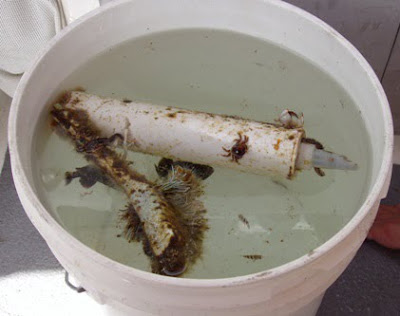I’ve had a lot of students asking what kind of fish or sea animals do we see - Turtles? Sharks? Dolphins? Manatees? I did get to see some dolphins while scuba diving in Hawaii and saw several sea turtles while exploring Kamilo Bay with Noni and Ron Sanford, but not since then. We swam while dolphin fish, otherwise known as Mahi Mahi, circled below down too deep to photograph. One night, we decided to flash lights over the ocean looking for Myctophids. When light hits them just right, their oversized eyes reflect a florescent red and they’re glowing photophor studded bodies make them look like fireflies of the sea. What we didn’t realize is our lights gave a school of Mahi Mahi the home court advantage and we found ourselves witnessing a feeding frenzy. The little five inch or so long Myctophids, twisted and contorted, zoomed and darted like kids playing dodge ball. I saw one jump over the head of a three foot Mahi Mahi. There were flashing fish and flashing flashlights going in all directions. Next thing we saw were squid getting into or getting out of the way of this dog eat dog world. Blotches of ink plumed the blue lit water.
Since we are on our way back to California with seas ranging from 5 to 7, cruising at 10 plus knots, weaving in and out of squalls, we haven’t had a chance to see much of anything. But today the sky turned blue, the captain put a line out, Bill threw the compost out and Jeff reeled in a Mahi Mahi (see picture above.) It was close to 30 inches long! Gwen examines the digestive tract for plastics and then Jeff took over. We’ll have it for lunch tomorrow. Good stuff!
To keep myself busy I decided to finish a project I started involving a poster using the inside of a shopping bag. We have a group of students from River Ridge High School, Florida who take part in AMRF’s Ship-to-Shore Educational Program that Holly Gray facilitates. Thanks Holly, you’ve recruited a great group of kids from all over the country and Canada!!! Well River Ridge High has a group of students known as the Reef Rascals soon to change there name to SPLASH (Students Protecting Land and Sea Habitats) who are getting some press and they asked for a photo from the gang out here. This was a little dicey since we all needed to be in it and with the boat bounces around so much self portraits are tough. We decided to use my video camera. So we all got in position in front of the camera and then just stared at it like “now what.” Without a “cheese” or “smile” or someone to say “Ready?” it left us all hanging until the captain, being the director of operations, began to sing M.I.C. K.E.Y. M.O.U.S.E. This was the most coherent picture I could extract from the footage. Great footage though.

RESPONSE TO COMMENTS
Jason, Hey thanks for a good attempt at the answer. I’ll share it with the captain. And great to hear you’re spreading the word. You are going to love the new camera/underwater case! Tell Danielle, I’ve pulled out the hat and I love it. Best Bro! bon
Hey Barrelmaker, Thanks for sharing because there are many of us who have never seen this before. Amazing for sure to think they substituted shells for plastic since gosh knows they were not near a location to grab a shell or 10. Best, Bonnie
What is that strapped to the pallet? We wish we could have found out. Unfortunately, we were doing our last sample of the 10 year anniversary resampling and could not stop what we were doing to go get it. We all lament over not being able to find out. The way it was trapped down, it looked important! Best, Bonnie
Hi again Tim, Your idea is not a bag one and we’re confident it happens as you describe. The only thing is, we pulled out 20 buoys many from calm seas and none of them were fouled like what the captain has seen in the past. We’re hoping to hear from a biologist. If you know one . . . .Best, Bonnie

















































